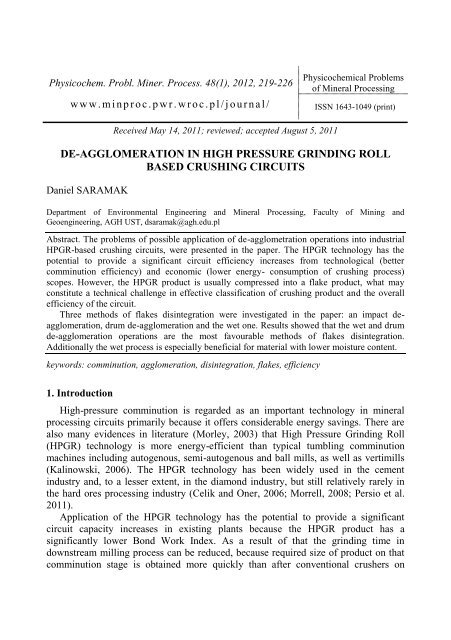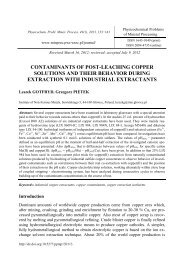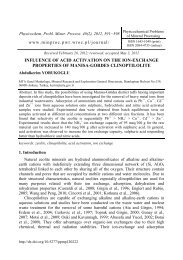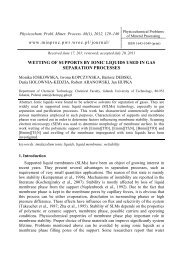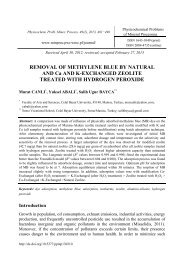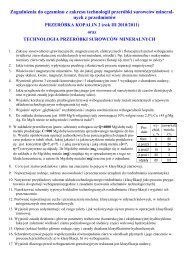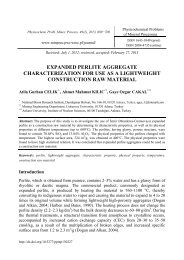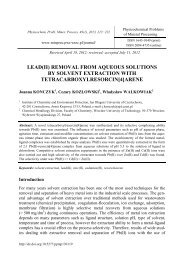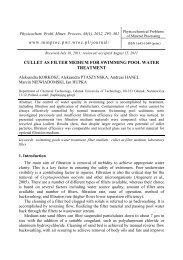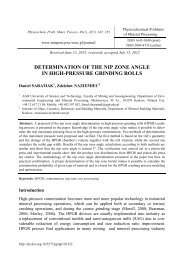De-agglomeration in high pressure grinding roll based crushing ...
De-agglomeration in high pressure grinding roll based crushing ...
De-agglomeration in high pressure grinding roll based crushing ...
Create successful ePaper yourself
Turn your PDF publications into a flip-book with our unique Google optimized e-Paper software.
Physicochem. Probl. M<strong>in</strong>er. Process. 48(1), 2012, 219-226<br />
w w w . m i n p r o c . p w r . w r o c . p l / j o u r n a l /<br />
Physicochemical Problems<br />
of M<strong>in</strong>eral Process<strong>in</strong>g<br />
ISSN 1643-1049 (pr<strong>in</strong>t)<br />
Received May 14, 2011; reviewed; accepted August 5, 2011<br />
DE-AGGLOMERATION IN HIGH PRESSURE GRINDING ROLL<br />
BASED CRUSHING CIRCUITS<br />
Daniel SARAMAK<br />
<strong>De</strong>partment of Environmental Eng<strong>in</strong>eer<strong>in</strong>g and M<strong>in</strong>eral Process<strong>in</strong>g, Faculty of M<strong>in</strong><strong>in</strong>g and<br />
Geoeng<strong>in</strong>eer<strong>in</strong>g, AGH UST, dsaramak@agh.edu.pl<br />
Abstract. The problems of possible application of de-agglometration operations <strong>in</strong>to <strong>in</strong>dustrial<br />
HPGR-<strong>based</strong> crush<strong>in</strong>g circuits, were presented <strong>in</strong> the paper. The HPGR technology has the<br />
potential to provide a significant circuit efficiency <strong>in</strong>creases from technological (better<br />
comm<strong>in</strong>ution efficiency) and economic (lower energy- consumption of crush<strong>in</strong>g process)<br />
scopes. However, the HPGR product is usually compressed <strong>in</strong>to a flake product, what may<br />
constitute a technical challenge <strong>in</strong> effective classification of crush<strong>in</strong>g product and the overall<br />
efficiency of the circuit.<br />
Three methods of flakes dis<strong>in</strong>tegration were <strong>in</strong>vestigated <strong>in</strong> the paper: an impact de<strong>agglomeration</strong>,<br />
drum de-<strong>agglomeration</strong> and the wet one. Results showed that the wet and drum<br />
de-<strong>agglomeration</strong> operations are the most favourable methods of flakes dis<strong>in</strong>tegration.<br />
Additionally the wet process is especially beneficial for material with lower moisture content.<br />
keywords: comm<strong>in</strong>ution, <strong>agglomeration</strong>, dis<strong>in</strong>tegration, flakes, efficiency<br />
1. Introduction<br />
High-<strong>pressure</strong> comm<strong>in</strong>ution is regarded as an important technology <strong>in</strong> m<strong>in</strong>eral<br />
process<strong>in</strong>g circuits primarily because it offers considerable energy sav<strong>in</strong>gs. There are<br />
also many evidences <strong>in</strong> literature (Morley, 2003) that High Pressure Gr<strong>in</strong>d<strong>in</strong>g Roll<br />
(HPGR) technology is more energy-efficient than typical tumbl<strong>in</strong>g comm<strong>in</strong>ution<br />
mach<strong>in</strong>es <strong>in</strong>clud<strong>in</strong>g autogenous, semi-autogenous and ball mills, as well as vertimills<br />
(Kal<strong>in</strong>owski, 2006). The HPGR technology has been widely used <strong>in</strong> the cement<br />
<strong>in</strong>dustry and, to a lesser extent, <strong>in</strong> the diamond <strong>in</strong>dustry, but still relatively rarely <strong>in</strong><br />
the hard ores process<strong>in</strong>g <strong>in</strong>dustry (Celik and Oner, 2006; Morrell, 2008; Persio et al.<br />
2011).<br />
Application of the HPGR technology has the potential to provide a significant<br />
circuit capacity <strong>in</strong>creases <strong>in</strong> exist<strong>in</strong>g plants because the HPGR product has a<br />
significantly lower Bond Work Index. As a result of that the gr<strong>in</strong>d<strong>in</strong>g time <strong>in</strong><br />
downstream mill<strong>in</strong>g process can be reduced, because required size of product on that<br />
comm<strong>in</strong>ution stage is obta<strong>in</strong>ed more quickly than after conventional crushers on
220 D. Saramak<br />
second stage (Ergun et al., 2004; Norgate and Weller, 1994). Other benefits of the<br />
<strong>high</strong>-<strong>pressure</strong> comm<strong>in</strong>ution concern the follow<strong>in</strong>g issues:<br />
- the energy efficiency of the circuit <strong>in</strong>creases with the proportion of<br />
comm<strong>in</strong>ution degree obta<strong>in</strong>ed <strong>in</strong> HPGR<br />
- the micro-crack generation is observable, what significantly lowers the<br />
energy-consumption <strong>in</strong> downstream gr<strong>in</strong>d<strong>in</strong>g processes<br />
- the specific capital costs per unit capacity for the HPGR-ball mill circuit are<br />
more than 20% lower than for the SABC circuits (Pahl, 1993)<br />
- the energy-consumption of circuit is also more beneficial for the HPGR-ball<br />
mill option, SABC circuit utilizes 20 to 30% more of energy (Saramak, 2011)<br />
- the term of delivery <strong>in</strong> new mach<strong>in</strong>es implementation is also shorter for HPGR<br />
units than for SAG mills<br />
- considerable smaller footpr<strong>in</strong>t of HPGR compar<strong>in</strong>g to the SAG unit<br />
- comparable costs of l<strong>in</strong><strong>in</strong>gs, but no costs of gr<strong>in</strong>d<strong>in</strong>g media costs for HPGR<br />
mach<strong>in</strong>es.<br />
The HPGR mach<strong>in</strong>es usually work <strong>in</strong> a closed circuit comb<strong>in</strong>ed with the screen<br />
(Fig. 1), from where the oversize product is recycled to the press (van der Meer and<br />
Gruendken, 2010; Naziemiec and Saramak, 2009; Saramak, 2011).<br />
Primary Crush<strong>in</strong>g<br />
(jaw, cone crusher)<br />
Screen<br />
Tertiary Crush<strong>in</strong>g<br />
(Ball Mill)<br />
Separation and chemical<br />
methods of beneficiation<br />
Fig. 1. Comm<strong>in</strong>ution circuit with HPGR<br />
device on second crush<strong>in</strong>g stage<br />
(Saramak et al., 2010)<br />
1.1. Problem def<strong>in</strong>ition<br />
The technical challenge <strong>in</strong> achiev<strong>in</strong>g effective classification of crush<strong>in</strong>g product<br />
occurs because the HPGR product is usually compressed <strong>in</strong>to a flake product. The<br />
strength of flakes is a proportional functional relationship of the operat<strong>in</strong>g <strong>pressure</strong>.<br />
Even though the comm<strong>in</strong>ution degree <strong>in</strong>creases together with the <strong>high</strong>er volumes of<br />
operat<strong>in</strong>g <strong>pressure</strong>, also the greater weight recovery of more competent flakes is<br />
observable <strong>in</strong> the HPGR product. Investigations <strong>in</strong> that matter carried out by the
% of flakes<br />
<strong>De</strong>-<strong>agglomeration</strong> <strong>in</strong> <strong>high</strong> <strong>pressure</strong> gr<strong>in</strong>d<strong>in</strong>g <strong>roll</strong> <strong>based</strong> crush<strong>in</strong>g circuits 221<br />
author show that an extensive generation of flakes takes place especially for <strong>high</strong>er<br />
volumes of operat<strong>in</strong>g <strong>pressure</strong> <strong>in</strong> middle and coarser size fractions of the product<br />
(Fig. 2).<br />
Low operat<strong>in</strong>g <strong>pressure</strong><br />
High operat<strong>in</strong>g <strong>pressure</strong><br />
30<br />
25<br />
20<br />
15<br />
10<br />
5<br />
0.02<br />
0.03<br />
0.04<br />
0.05<br />
0.07<br />
0.10 0.14<br />
d/dmax<br />
0.20<br />
0.28<br />
0.40<br />
0.48<br />
0.80<br />
0<br />
Fig. 2. Flakes mass recoveries <strong>in</strong> HPGR products crushed under <strong>high</strong> and low operat<strong>in</strong>g <strong>pressure</strong><br />
On-site experiments <strong>in</strong> iron and gold ore process<strong>in</strong>g plants enable author to state<br />
that together with <strong>in</strong>creas<strong>in</strong>g the operat<strong>in</strong>g <strong>pressure</strong> <strong>in</strong> the HPGR press, the mass flow<br />
of the oversize screen<strong>in</strong>g product, which is recycled to the press, is <strong>high</strong>er too. The<br />
greater volume of operat<strong>in</strong>g <strong>pressure</strong>, the more considerable share of flakes <strong>in</strong> recycle<br />
mass flow what significantly decreases the overall efficiency of comm<strong>in</strong>ution circuit.<br />
Apart from the operat<strong>in</strong>g <strong>pressure</strong>, the flakes competency is a function of the ore type<br />
and the moisture content. Generally, competent flakes are be<strong>in</strong>g generated to a larger<br />
extent <strong>in</strong> softer ores or those with <strong>in</strong>creased clay content (like kimberlites), while<br />
harder ores tend to produce rather fragile flakes.<br />
1.2. <strong>De</strong>-<strong>agglomeration</strong> process<br />
A method of overcom<strong>in</strong>g of competent flakes generation is the implementation to<br />
the circuit the operation of the HPGR product de-<strong>agglomeration</strong>. This operation can be<br />
also utilized depend<strong>in</strong>g on the technological process requirements or the flakes<br />
competency. This is a significant issue <strong>in</strong> the flow-sheet development; it enhances the<br />
circuit efficiency, reduc<strong>in</strong>g the recirculation of already crushed material, which could<br />
be otherwise recycled to the press with<strong>in</strong> the flakes.<br />
Various de-<strong>agglomeration</strong> methods can be applied <strong>in</strong>to the flow-sheet. Flakes<br />
product may be de-agglomerated by us<strong>in</strong>g rotary drum scrubbers, drums with lifter<br />
bars, by handl<strong>in</strong>g <strong>in</strong> chutes and b<strong>in</strong>s, utiliz<strong>in</strong>g the impact forces (hammer mill or<br />
vertical impactor followed by the screen<strong>in</strong>g operation) or even on vibrat<strong>in</strong>g screens<br />
(especially <strong>in</strong> wet screen<strong>in</strong>g operations). Wet screen<strong>in</strong>g of the HPGR product is<br />
regarded as a mild de-<strong>agglomeration</strong>. When <strong>in</strong>tense de-<strong>agglomeration</strong> is required, the<br />
HPGR product is delivered directly to the mill, the mill discharge is screened and the<br />
screen oversize is returned to the HPGR. Some methods of de-<strong>agglomeration</strong> are<br />
possible to implement without the need of add<strong>in</strong>g any extra mach<strong>in</strong>es to the
222 D. Saramak<br />
technological circuit. An impact de-<strong>agglomeration</strong> can be done even on the vibrat<strong>in</strong>g<br />
screen, where either the dry or wet process can be carried out.<br />
The technological flow-sheet configuration for a given material is driven by the<br />
requirements of the process and consideration of the crush<strong>in</strong>g devices characteristics<br />
(ma<strong>in</strong>ly HPGR). In particular, the mass of possible f<strong>in</strong>es recirculation and existence of<br />
a separate de-<strong>agglomeration</strong> operation will have a significant effect on the formulation<br />
of the flow-sheet technological and economic efficiency. The need and type of<br />
possible de-<strong>agglomeration</strong> operation can be assessed by suitable tests. The ma<strong>in</strong> aim<br />
of such tests is to identify suitable de-<strong>agglomeration</strong> and classification variant for the<br />
HPGR product dis<strong>in</strong>tegration.<br />
2. Experimetal programme<br />
The ma<strong>in</strong> aim of the paper was to exam<strong>in</strong>e different methods of de-<strong>agglomeration</strong>.<br />
Two tests were carried out <strong>in</strong> follow<strong>in</strong>g manner: test one was proceeded for material<br />
under natural moisture condition (about 2%), while <strong>in</strong> test 2 the feed moisture was<br />
<strong>in</strong>creased to about 4%. This enabled to <strong>in</strong>vestigate an <strong>in</strong>fluence of both the method of<br />
de-<strong>agglomeration</strong> and the selected feed condition (the moisture) on the de<strong>agglomeration</strong><br />
process efficiency. In laboratory tests the iron ore with the bulk density<br />
approximately 2.0 g/cm³ and the hematite content about 60% was used, which was<br />
entirely crushed <strong>in</strong> laboratory HPGR unit. Table 1 summarizes technological<br />
parameters of the HPGR crush<strong>in</strong>g process.<br />
Table 1. HPGR tests summary<br />
Test 1 Test 2<br />
Operat<strong>in</strong>g press<strong>in</strong>g force [kN] 8 000 8 000<br />
Speed of <strong>roll</strong>s [m/s] 0.4 0.4<br />
Roller diameter [m] 0.2 0.2<br />
Roller width [m] 0.15 0.15<br />
Type of l<strong>in</strong><strong>in</strong>gs pla<strong>in</strong> pla<strong>in</strong><br />
Type of material Iron ore Iron ore<br />
Feed d max [mm] 10 10<br />
Feed moisture content [%] 2 4<br />
The HPGR centre product from each test was then split <strong>in</strong>to three representative<br />
samples designed for further de-<strong>agglomeration</strong> tests. Sample 1 was de-agglomerated <strong>in</strong><br />
hands to obta<strong>in</strong> ideal dis<strong>in</strong>tegration of flakes and this sample was treated as a reference<br />
one. The flakes content <strong>in</strong> every s<strong>in</strong>gle sample was analyzed with<strong>in</strong> the size fraction of<br />
1.168–4 mm, additionally the mass recoveries of -3.15 mm material were determ<strong>in</strong>ed.<br />
3. Experimental results<br />
Screen analyses of both reference samples together with particle size distribution<br />
curve of feed are presented <strong>in</strong> Fig. 3.
mass recovery [%]<br />
mass recovery [%]<br />
<strong>De</strong>-<strong>agglomeration</strong> <strong>in</strong> <strong>high</strong> <strong>pressure</strong> gr<strong>in</strong>d<strong>in</strong>g <strong>roll</strong> <strong>based</strong> crush<strong>in</strong>g circuits 223<br />
The results has shown that both de-agglomerated samples have a content of almost<br />
80% of particles smaller than 3.15 mm and the <strong>in</strong>fluence of different moisture of<br />
samples is of a rather low importance if about the HPGR product particle size.<br />
100<br />
90<br />
80<br />
70<br />
60<br />
50<br />
40<br />
30<br />
20<br />
10<br />
0<br />
Feed<br />
HPGR product test 1<br />
HPGR product test 2<br />
0 2 4 6 8 10 12<br />
particle size [mm]<br />
Fig. 3. Particle size distribution curves of feed and crush<strong>in</strong>g products<br />
3.1. Impact de-<strong>agglomeration</strong><br />
The first de-<strong>agglomeration</strong> method under <strong>in</strong>vestigation was the drop test. In that<br />
test the <strong>in</strong>fluence of impact forces on the de-<strong>agglomeration</strong> process were exam<strong>in</strong>ed.<br />
The material flakes were dropped from the height of 1 meter, and then screened.<br />
100<br />
90<br />
80<br />
70<br />
60<br />
50<br />
40<br />
30<br />
20<br />
10<br />
0<br />
2% 1 4% 1<br />
2% 2 4% 2<br />
2% 3 4% 3<br />
0 1 2 3 4 5<br />
particle size [mm]<br />
Fig. 4. Impact de-<strong>agglomeration</strong><br />
The procedure has been repeated three times for each sample. Results are presented<br />
<strong>in</strong> Fig. 4. The results show that with every drop the mass recovery of particles smaller<br />
than 3,15 mm steadily <strong>in</strong>creas<strong>in</strong>g, but even after third drop it cannot even approach the<br />
value of 80% obta<strong>in</strong>ed for HPGR products. The impact de-<strong>agglomeration</strong> is also more
mass recovery [%]<br />
224 D. Saramak<br />
efficient for the material with lower moisture content for several percent. After each<br />
consecutive drop the weight recovery of –3.15mm product <strong>in</strong>creases, but the growth is<br />
smaller than after previous drop.<br />
The impact de-<strong>agglomeration</strong> is relatively simple to implement, even without<br />
add<strong>in</strong>g no mach<strong>in</strong>e to the circuit. It can be obta<strong>in</strong>ed for example dur<strong>in</strong>g the screen<strong>in</strong>g<br />
process by implement<strong>in</strong>g a suitable screen evok<strong>in</strong>g a <strong>high</strong>er vertical trajectory of the<br />
particle movement.<br />
3.2. Drum de-<strong>agglomeration</strong><br />
On the contrary to the impact de-<strong>agglomeration</strong>, the drum de-<strong>agglomeration</strong><br />
process must take place <strong>in</strong> a separate mach<strong>in</strong>e, usually the rotary drum with lifters or<br />
rotors. A laboratory test was carried out <strong>in</strong> a 0.5 m diameter drum with two lifter bars.<br />
The samples were treated <strong>in</strong> the drum for 10, 20 and 30 seconds, while the drum<br />
rotated with speed slightly lower than 1 rev/s. After each test, the sieve analysis was<br />
performed and results are presented <strong>in</strong> Fig. 5.<br />
100<br />
90<br />
80<br />
70<br />
60<br />
50<br />
40<br />
30<br />
20<br />
10<br />
0<br />
2% 10' 4% 10'<br />
2% 20' 4% 20'<br />
2% 30' 4% 30'<br />
0 1 2 3 4 5<br />
particle size [mm]<br />
Fig. 5. Drum de-<strong>agglomeration</strong> results<br />
The test has shown that obta<strong>in</strong>ed results are better compar<strong>in</strong>g to the drop tests. Just<br />
after 10 seconds of material tumbl<strong>in</strong>g, the de-<strong>agglomeration</strong> results were more<br />
favorable than after two drops <strong>in</strong> impact tests. After 30 seconds of tumbl<strong>in</strong>g time the<br />
products conta<strong>in</strong>ed only 10 – 15% of flakes exceed<strong>in</strong>g 3.15 mm (+3.15mm particles<br />
content was 75% for drum de-<strong>agglomeration</strong> and 85-90% for the de-agglomerated<br />
HPGR product – see Fig. 3). Furthermore, the moisture <strong>in</strong>fluence on the obta<strong>in</strong>ed<br />
results is of a m<strong>in</strong>or importance.<br />
3.4. Wet de-<strong>agglomeration</strong><br />
Apart from the above <strong>in</strong>vestigations, an additional test was carried out. The sample<br />
was laid for several m<strong>in</strong>utes <strong>in</strong> a water bath. After the water treatment the material was
<strong>De</strong>-<strong>agglomeration</strong> <strong>in</strong> <strong>high</strong> <strong>pressure</strong> gr<strong>in</strong>d<strong>in</strong>g <strong>roll</strong> <strong>based</strong> crush<strong>in</strong>g circuits 225<br />
screened on a sieve with 3.15 mm mesh. This method of de-<strong>agglomeration</strong> can be<br />
obta<strong>in</strong>ed by the wet screen<strong>in</strong>g of the HPGR product. Under operat<strong>in</strong>g conditions, the<br />
screen<strong>in</strong>g process should be modified respectively, because the material should be<br />
<strong>in</strong>tensively spr<strong>in</strong>kled with water, and the screen<strong>in</strong>g time needs to be optimized as well.<br />
The sample with 4% of moisture was <strong>in</strong>vestigated by that method and the weight<br />
recovery of -3.15 mm particles was as <strong>high</strong> as 83%. The result for 2%-sample was<br />
practically identical. This result shows that the soak<strong>in</strong>g of material is the most efficient<br />
method of de-<strong>agglomeration</strong>, because the flakes content <strong>in</strong> screen oversize product<br />
(-3.15 mm) is 3 to 8%. Table 2 also presents comm<strong>in</strong>ution degrees obta<strong>in</strong>ed <strong>in</strong> impact<br />
and drum de-<strong>agglomeration</strong> processes.<br />
Table 3 summarizes the test results presented <strong>in</strong> the paper.<br />
Table 2. Technological effects for both de-<strong>agglomeration</strong> methods<br />
HPGR product Impact de-<strong>agglomeration</strong> Drum de-<strong>agglomeration</strong><br />
2% 4% 2% 4% 2% 4%<br />
S50 3.2 3.44 1.34 1.39 1.76 1.89<br />
S80 2.92 3.42 2.10 1.86 2.29 2.33<br />
Table 3. Percentage weight recoveries of -3.15 mm particle fraction <strong>in</strong> all samples<br />
Type of test 2% moisture content 4% moisture content<br />
<strong>De</strong>-agglomerated product 85.9 92.2<br />
Impact de-<strong>agglomeration</strong> 63.8 63.5<br />
Drum de-<strong>agglomeration</strong> 73.2 74.8<br />
Wet de-<strong>agglomeration</strong> 83<br />
4. Summary and conclusions<br />
Results show that the wet de-<strong>agglomeration</strong> and next the drum process are two the<br />
most favorable methods of flakes dis<strong>in</strong>tegration. The wet process is especially<br />
beneficial for material with lower moisture content, because only about 3% of material<br />
stays as flakes. The satisfactory flakes dis<strong>in</strong>tegration can be also obta<strong>in</strong>ed when the<br />
drum de-<strong>agglomeration</strong> method is implemented. For material moisture content of 2%<br />
the flakes content is about 10% or less. The impact de-<strong>agglomeration</strong> for this type of<br />
material appeared as a less efficient method.<br />
The material with <strong>high</strong>er moisture content produced a more favorable value of<br />
overall comm<strong>in</strong>ution degree, no matter of the method of de-<strong>agglomeration</strong>. However,<br />
the <strong>high</strong>er comm<strong>in</strong>ution level was weakened by the lower ratio of dis<strong>in</strong>tegrated flakes<br />
(Table 3) for products with <strong>high</strong>er moisture content. As a result of that, a part of<br />
undersize f<strong>in</strong>es stays <strong>in</strong> the oversize screen<strong>in</strong>g product as flakes and they are recycled<br />
to the press aga<strong>in</strong>, decreas<strong>in</strong>g the process efficiency.<br />
The proper selection of de-<strong>agglomeration</strong> method should be made <strong>in</strong> general on the<br />
basis of three aspects: the first issue ought to take <strong>in</strong>to account the type of material<br />
crushed, the second one should consider the desired degree of flakes dis<strong>in</strong>tegration,
226 D. Saramak<br />
while the third one the technological parameters of the HPGR operation. Application<br />
of the de-<strong>agglomeration</strong> operation <strong>in</strong>to the technological circuit can be carry out <strong>in</strong><br />
several ways. Connect<strong>in</strong>g po<strong>in</strong>ts between two conveyors can be a suitable place for<br />
<strong>in</strong>stallation the impact plates (mild de-<strong>agglomeration</strong>), if the height is as <strong>high</strong> as 2<br />
meters of more. Another solution of mild de-<strong>agglomeration</strong> is the flush<strong>in</strong>g of material<br />
onto the screen with excessive addition of water. When the process <strong>in</strong>volves more<br />
<strong>in</strong>tense process of particle dis<strong>in</strong>tegration, the drums should be applied together with<br />
mechanical treatment of moist flakes dur<strong>in</strong>g the screen<strong>in</strong>g process.<br />
Acknowledgments<br />
The article is an effect of Polish M<strong>in</strong>istry of Science research grant N N524 466139.<br />
References<br />
Celik I.B., Oner M., 2006, The <strong>in</strong>fluence of gr<strong>in</strong>d<strong>in</strong>g mechanism on the liberation characteristics of<br />
cl<strong>in</strong>ker m<strong>in</strong>erals, Cement and Concrete Research, 36 (3), 422–427.<br />
Ergün L., Ekmekçi Z., Gülsoy O., Benzer H., 2004, Modell<strong>in</strong>g and simulation of gr<strong>in</strong>d<strong>in</strong>g circuit <strong>in</strong><br />
Madneuli copper concentrator, Physicochemical Problems of M<strong>in</strong>eral Process<strong>in</strong>g 38, 231–240.<br />
Kal<strong>in</strong>owski W., 2006, Modernizacja procesów przemiałowych w przemyśle cementowym w świetle<br />
wymagań najlepszych dostępnych technik, Surowce i Maszyny Budowlane no. 1/2006.<br />
Morley C., 2003, HPGR <strong>in</strong> hard rock applications, M<strong>in</strong><strong>in</strong>g Magaz<strong>in</strong>e, IX/2003.<br />
Morrell S., 2008, A method for predict<strong>in</strong>g the specific energy requirement of comm<strong>in</strong>ution circuits and<br />
assess<strong>in</strong>g their energy utilization efficiency, M<strong>in</strong>erals Eng<strong>in</strong>eer<strong>in</strong>g 21, 224–233.<br />
Naziemiec Z., Saramak D., 2009, Analiza zmian obciążenia materiału w strefie zgniotu pras walcowych,<br />
Górnictwo i Geo<strong>in</strong>żynieria 4.<br />
Norgate, T.E., Weller K.R., 1994, Selection and operation of <strong>high</strong> <strong>pressure</strong> gr<strong>in</strong>d<strong>in</strong>g <strong>roll</strong>s circuits for<br />
m<strong>in</strong>imum energy consumption, M<strong>in</strong>erals Eng<strong>in</strong>eer<strong>in</strong>g, 7 (10), 1253–1267.<br />
Pahl M. H., 1993, Praxiswissen Verfahrenstechnik – Zerkle<strong>in</strong>erungstechnik. Fachbuchverlag<br />
Leipzig/Verlag TÜV Rhe<strong>in</strong>land, Köln.<br />
Persio Rosario P, Hall R., Grundy M., Kle<strong>in</strong> B., 2011, A prelim<strong>in</strong>ary <strong>in</strong>vestigation <strong>in</strong>to the feasibility of a<br />
novel HPGR-<strong>based</strong> circuit for hard, weathered ores conta<strong>in</strong><strong>in</strong>g clayish material, M<strong>in</strong>erals<br />
Eng<strong>in</strong>eer<strong>in</strong>g, 24 (3–4), 290–302.<br />
Saramak D., 2010, Analiza powiązań pomiędzy parametrami technologicznymi pras walcowych z<br />
wykorzystaniem analizy czynnikowej, ZN AGH Górnictwo i Geo<strong>in</strong>żynieria, rok 34, zeszyt 4/1.<br />
Saramak D., 2011, Technological issues of High-Pressure Gr<strong>in</strong>d<strong>in</strong>g Rolls operation <strong>in</strong> ore comm<strong>in</strong>ution<br />
processes, Archives of M<strong>in</strong><strong>in</strong>g Sciences, 56 (<strong>in</strong> press).<br />
Saramak D., Tumidajski T., Brożek M., Gawenda T., Naziemiec Z., 2010, Aspects of comm<strong>in</strong>ution<br />
flowsheets design <strong>in</strong> process<strong>in</strong>g of m<strong>in</strong>eral raw materials, Gospodarka Surowcami M<strong>in</strong>eralnymi 26, 4,<br />
59-69.<br />
van der Meer F.P., Gruendken A., 2010, Flowsheet considerations for optimal use of <strong>high</strong> <strong>pressure</strong><br />
gr<strong>in</strong>d<strong>in</strong>g <strong>roll</strong>s, M<strong>in</strong>erals Eng<strong>in</strong>eer<strong>in</strong>g, 23 (9), 663–669.


